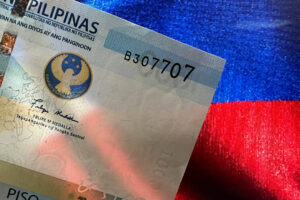




Policy Rate Updates: Double cut finale
 DOWNLOAD
DOWNLOAD

Monthly Economic Update: One for the road
 DOWNLOAD
DOWNLOAD

Inflation Update: Still low, still slow
 DOWNLOAD
DOWNLOAD


Peso may continue to weaken ahead of BSP policy meeting

The peso may continue weakening against the dollar this week ahead of the Bangko Sentral ng Pilipinas’ (BSP) rate-setting meeting on Thursday.
The local unit closed at a near nine-month low of PHP 56.315 versus the dollar on Friday, weakening by 9.5 centavos from Thursday’s PHP 56.22 finish, data from the Bankers Association of the Philippines’ website showed.
This was the peso’s worst close since its PHP 56.56-per-dollar finish on Nov. 29, 2022.
Week on week, the peso dropped by 57.5 centavos from its PHP 55.74 close on Aug. 4.
The local unit opened Friday’s session at PHP 56.23 per dollar. Its intraday best was at PHP 56.10, while its weakest showing was at PH PHP 56.34 against the greenback.
Dollars traded rose to USD 1.43 billion on Friday from the USD 1.24 billion recorded on Thursday.
The peso declined further against the dollar on Friday as the market continued to reel from the weak second-quarter gross domestic product (GDP) report, Rizal Commercial Banking Corp. Chief Economist Michael L. Ricafort said in a Viber message.
The Philippine economy expanded by 4.3% in the second quarter, the slowest in two years, Philippine Statistics Authority data released on Thursday showed.
The second-quarter print was slower than the revised 6.4% growth in the first quarter and 7.5% in the same period a year earlier. It was also well below the 6% median forecast in a BusinessWorld poll of 21 economists conducted earlier this month.
For the first half, GDP growth averaged 5.3%, lower than the government’s 6-7% target.
The peso was also dragged down by hawkish Fed signals despite cooling inflation, Mr. Ricafort added.
San Francisco Federal Reserve Bank President Mary Daly on Thursday said that while recent inflation data is moving in the right direction, more progress is needed before she would feel comfortable the Fed has done enough, Reuters reported.
While goods inflation is receding, and newly signed lease trends signal inflation from housing will also cool, core services inflation excluding housing has so far made little progress, Ms. Daly said.
The Fed raised borrowing costs by 25 basis points (bps) in its July 25-26 meeting, bringing its benchmark overnight rate to a range between 5.25% and 5.5%.
The US central bank has hiked rates by a cumulative 525 bps since it began its tightening cycle in March last year.
The Fed will hold its next policy meeting on Sept. 19-20.
US consumer prices increased moderately in July as higher rents were mostly offset by declining costs of goods such as motor vehicles and furniture, a trend that could persuade the Fed to leave interest rates unchanged next month.
The consumer price index (CPI) rose by 0.2% last month, matching the gain in June.
The CPI advanced 3.2% in the 12 months through July. That followed a 3% rise in June, which was the smallest year-on-year gain since March 2021.
The increase in the annual CPI rate picked up for the first time in 13 months as it was calculated from a lower base after prices subsided last July following a jump that had boosted inflation to a pace not seen in more than 40 years.
Annual consumer prices have come down from a peak of 9.1% in June 2022. The CPI increased at a 1.9% annualized rate over the last three months, the slowest pace since June 2020, from 2.7% in June. The Fed has a 2% inflation target.
For this week, Mr. Ricafort said the peso could stay at the PHP 56-per-dollar level as the market awaits the BSP’s policy meeting on Thursday.
A BusinessWorld poll last week showed 13 of 15 analysts see the Monetary Board keeping benchmark rates steady at 6.25% during its fifth policy meeting for the year on Aug. 17.
Meanwhile, two economists expect the BSP to hike borrowing costs by 25 bps to mirror the Fed’s move last month. If realized, this would bring the key rate to 6.5%.
The market will also await the release of the minutes of the Fed’s latest rate-setting meeting this week, Mr. Ricafort said.
He expects the peso to range from PHP 56 to PHP 56.50 per dollar this week. — A.M.C. Sy with Reuters
This article originally appeared on bworldonline.com





 By BusinessWorld
By BusinessWorld